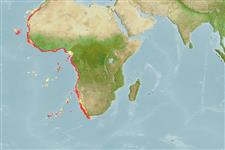Common names from other countries
Classification / Names / Names
Nomi Comuni | Sinonimi | Catalog of Fishes (gen., sp.) | ITIS | CoL | WoRMS
Environment: milieu / climate zone / depth range / distribution range
Ecologia
; distribuzione batimetrica 100 - 950 m (Ref. 804), usually 300 - 700 m (Ref. 435). Tropical; 31°N - 36°S, 26°W - 21°E
Eastern Atlantic: West to southwest Africa.
Length at first maturity / Size / Peso / Age
Maturity: Lm ?, range 8 - 10 cm Max length : 16.0 cm CW maschio/sesso non determinato; (Ref. 435); 9.5 cm CW (female)
Inhabits muddy bottoms at depths of 100 to 936 m, common between 300 to 700 m (Ref. 435). Also in muddy-sandy bottoms (Ref. 101384). Tends to aggregate in areas near canyons and other bottom features (Ref. 2677). In general, adult geryonid crabs are opportunistic feeders (Ref. 104380).
Mating behavior: Newly moulted or soft-shelled female is carried by the male with its pleopods
Fischer, W., G. Bianchi and W.B. Scott (eds.). 1981. (Ref. 435)
IUCN Red List Status (Ref. 130435)
CITES status (Ref. 108899)
Not Evaluated
Not Evaluated
Threat to humans
Harmless
Human uses
Pesca: commerciale
| FishSource | Sea Around Us
Strumenti
Informazioni ulteriori
Age/SizeAccrescimentoLength-weightLength-lengthMorfologiaLarveAbbondanza
Fonti Internet
Estimates based on models
Preferred temperature
(Ref.
115969): 5.5 - 12, mean 8.4 (based on 58 cells).
Prior r = 0.42, 95% CL = 0.28 - 0.63, Based on 1 data-limited stock assessment.
Vulnerability
Low vulnerability (10 of 100).
